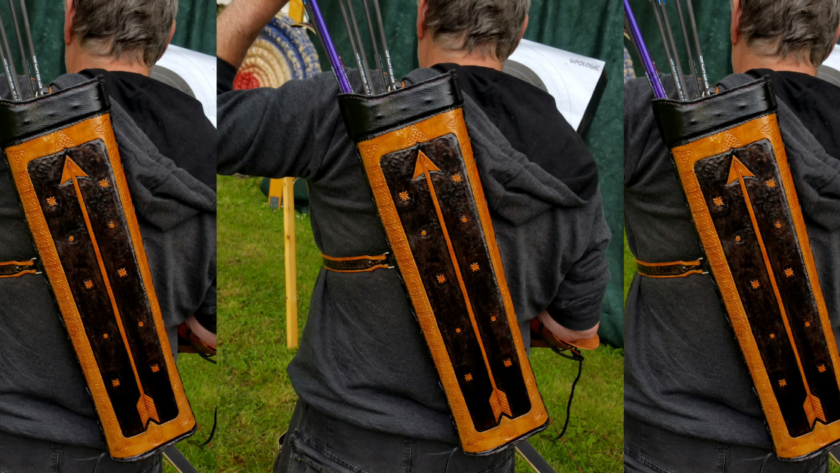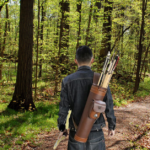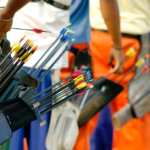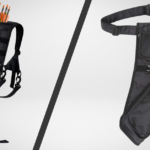The right quiver can significantly impact your hunting success, affecting everything from stealth to shot accuracy. In this guide, I’ll share my hard-earned insights on selecting the best back quiver for your broadhead-tipped arrows.
The Anatomy of an Ideal Back Quiver
Several key components work together to create a superior back quiver for broadheads. Let’s break down these essential elements:
Arrow Protection
A quiver’s primary function is to protect your arrows. The best back quivers for broadheads feature individual arrow compartments.
This design prevents damage to your fletching and broadheads.
Individual compartments eliminate tangled arrows and dulled broadheads, ensuring each arrow stays pristine until the moment you need it.
Material Selection
The choice of material significantly impacts a quiver’s performance. High-quality leather offers a perfect blend of durability and silence.
Modern synthetic materials provide superior weather resistance and lighter weight.
A hybrid approach often yields the best results. Look for quivers that mix the classic appeal of leather with strategic use of advanced synthetics in high-wear areas.
Noise Reduction
Stealth is paramount in bowhunting. The best back quivers incorporate noise-reduction features such as fleece-lined compartments or silent closure systems.
Excellent noise dampening properties can make a world of difference in your hunting success.
Capacity and Weight
The ideal arrow capacity varies depending on your hunting style, but most hunters find that 8-12 arrows strike the right balance between preparedness and maneuverability. Weight is equally crucial – a heavy quiver can throw off your balance and tire you out on long treks.
Look for quivers that offer sufficient capacity without adding unnecessary bulk.
Some of the best models incorporate lightweight materials and clever design to maximize arrow storage while minimizing weight.
Adjustability
Your quiver should adapt to you. The best back quivers feature adjustable straps that accommodate different body types and clothing layers.
This adaptability confirms comfort and proper positioning, which is crucial for quick and silent arrow retrieval.
Implementing Your Quiver Strategy
Choosing the right back quiver is only half the battle. To truly maximize it’s benefits, you need to combine it seamlessly into your hunting routine.
Here’s a step-by-step guide to implementing your new quiver strategy:
Proper Positioning
Experiment with the quiver’s position on your back. The ideal spot allows for easy reach without impeding your draw or movement.
Practice drawing arrows in various hunting positions to find your sweet spot.
Consider factors like your dominant hand, shooting style, and typical hunting scenarios.
Arrow Organization
Arrange your arrows strategically within the quiver. Place your go-to arrows in the most accessible slots, with backup options further back.
Consider organizing arrows based on broadhead type, arrow weight, or intended target.
This systematic approach can save precious seconds when every moment counts.
Silent Drawing Practice
Spend time practicing silent arrow removal. This skill can make or break a hunting opportunity.
Focus on smooth, deliberate movements to minimize noise.
Practice in various positions, including seated, kneeling, and standing. Pay attention to potential sources of noise, such as arrow shafts rubbing against each other or the quiver material.
Weather Adaptation
Learn how your quiver performs in different weather conditions. Some materials may need extra waterproofing or maintenance in wet environments.
Test your quiver in various conditions, from hot and humid to cold and rainy.
Make note of any adjustments needed to maintain optimal performance across different weather scenarios.
Integration with Other Gear
Ensure your quiver works harmoniously with your other hunting equipment. Test it with your backpack, safety harness, and any other gear you typically use.
Pay attention to potential interference or compatibility issues.
Make adjustments as needed to create a seamless system that enhances your overall hunting experience.
Overcoming Common Quiver Challenges
Even the best back quivers can present challenges. Here are some common issues and how to address them:
Arrow Rattle
If you’re experiencing unwanted noise, try adding small foam inserts or rubber bands to secure arrows more tightly. Experiment with different materials and placement to find the most effective solution for your specific quiver and arrow combination.
Weight Distribution
An improperly balanced quiver can affect your shooting. Experiment with arrow placement and quiver position to find the optimal balance point.
Consider redistributing weight by adjusting the number of arrows or their placement within the quiver.
Pay attention to how the quiver’s weight affects your overall balance and shooting form.
Broadhead Dulling
Sharp broadheads are crucial for ethical and effective hunting. Use protective caps or opt for quivers with built-in broadhead covers to maintain edge sharpness.
Regularly inspect your broadheads for signs of dulling or damage.
Consider investing in a portable broadhead sharpener for quick touch-ups in the field.
Scent Control
Leather quivers can absorb odors. Implement a strict scent control regimen, including regular cleaning and storage in scent-free containers.
Use odor-eliminating sprays or wipes specifically designed for hunting gear.
Store your quiver in a scent-free bag when not in use, and avoid exposing it to strong odors that could compromise your hunt.
Adapting Your Quiver for Different Hunting Scenarios
Versatility is important in hunting, and your quiver should be adaptable to various situations:
Tree Stand Hunting
When hunting from an elevated position, consider how you’ll access your quiver. Some hunters prefer to hang their quiver on the tree for easier access.
Practice transitioning your quiver from your back to a hanging position quietly and efficiently.
Ensure your quiver is securely attached to prevent accidental drops.
Spot-and-Stalk
For this mobile hunting style, a lightweight, close-fitting quiver is essential. Look for models that hug your body to minimize snagging on brush.
Practice moving through dense vegetation with your quiver to identify any potential issues.
Consider using a quiver cover or sleeve to protect your arrows and reduce noise when navigating through thick brush.
Cold Weather Hunting
In frigid conditions, confirm your quiver allows for easy arrow retrieval with gloved hands. Some hunters prefer to remove a few arrows and keep them in an easily accessible side quiver for quick shots.
Test your quiver’s performance with different types of gloves to confirm compatibility.
Consider adding insulation to your quiver to protect your arrows from extreme temperatures.
Advancing Your Quiver Mastery
As you become more proficient with your back quiver, you’ll explore nuances that can further enhance your hunting experience:
Custom Modifications
Don’t be afraid to change your quiver to suit your needs better. Simple additions like extra padding or a small accessory pouch can make a big difference.
Consider adding reflective tape for improved visibility in low-light conditions.
Experiment with different arrow retention systems to find the perfect balance between security and ease of access.
Quiver Rotation
Some advanced hunters use multiple quivers, rotating them based on the specific hunting conditions or prey. This approach allows for specialized setups without compromising versatility.
Develop a system for quickly swapping quivers in the field.
Consider creating purpose-built quivers for different hunting scenarios, such as a lightweight version for long hikes or a heavy-duty model for rugged terrain.
Scent Dispersion
Your quiver can double as a scent dispersion tool. Attaching scent wicks or using scent-infused materials can help mask your presence in the field.
Experiment with different scent strategies, such as using cover scents or attractants depending on your hunting goals.
Be mindful of wind direction when utilizing your quiver for scent dispersion.
Practical Exercises for Quiver Proficiency
To truly master your back quiver, incorporate these exercises into your practice routine:
Timed Arrow Retrieval
Set up targets at various distances and practice quickly and silently retrieving and nocking arrows from your quiver. Start with a simple setup and gradually increase complexity by adding obstacles or varying target positions.
Time yourself and track your progress to identify areas for improvement.
Obstacle Course
Create a simple obstacle course that mimics hunting conditions. Navigate it while drawing arrows, focusing on maintaining stealth and efficiency.
Include elements like low branches, dense brush, and uneven terrain to simulate real-world challenges.
Practice moving through the course in different weather conditions to enhance your adaptability.
Blind Draw Practice
In a safe environment, practice drawing arrows with your eyes closed. This exercise enhances muscle memory and improves your ability to retrieve arrows in low-light conditions. Start with a stationary position and progress to moving scenarios.
Focus on developing a consistent and repeatable motion for arrow retrieval.
Weather Simulation
Practice using your quiver in various simulated weather conditions. Use a sprinkler for rain or wear bulky clothing for cold weather scenarios.
Pay attention to how different weather conditions affect your quiver’s performance and your ability to access arrows quickly and quietly.
Develop strategies for maintaining your quiver’s effectiveness in challenging environments.
The Science Behind Quiver Design
Understanding the principles behind quiver design can help you make more informed choices and appreciate the engineering that goes into high-quality products.
Aerodynamics and Balance
A well-designed quiver minimizes wind resistance and maintains proper balance when attached to your bow or back. Manufacturers use wind tunnel testing and computer simulations to improve quiver shapes for reduced drag.
The placement of arrows within the quiver is carefully considered to distribute weight evenly and minimize impact on shooting form.
Materials Science
Advanced materials play a crucial role in modern quiver design. Carbon fiber composites offer exceptional strength-to-weight ratios, while specialized polymers provide durability and weather resistance.
Some quivers incorporate memory foam or gel inserts for arrow protection and noise reduction.
Understanding the properties of different materials can help you choose a quiver that best suits your needs and hunting environment.
Ergonomics and Biomechanics
The study of human movement and comfort tells quiver design, particularly for back quivers. Manufacturers analyze the natural range of motion for archers and hunters to create quivers that move with the body as opposed to against it.
Strap placement, padding distribution, and overall quiver shape are all influenced by ergonomic principles to enhance comfort during long hunting sessions.
Maintenance and Care for Your Back Quiver
Proper maintenance confirms your quiver performs optimally and lasts for many hunting seasons.
Cleaning and Drying
Regularly clean your quiver to remove dirt, debris, and potential scent contaminants. Use mild soap and water for synthetic materials, and specialized leather cleaners for leather quivers.
Always allow your quiver to air dry completely before storage to prevent mold and mildew growth.
Inspecting for Wear
Periodically examine your quiver for signs of wear, such as frayed straps, loose stitching, or damaged arrow compartments. Address minor issues promptly to prevent them from becoming major problems.
Pay special attention to high-stress areas like attachment points and often used arrow slots.
Storage Best Practices
Store your quiver in a cool, dry place away from direct sunlight when not in use. For leather quivers, use leather conditioner occasionally to prevent cracking and maintain flexibility.
Keep your quiver away from heat sources and extreme temperatures, which can damage materials and affect performance.
Seasonal Preparation
Before each hunting season, perform a thorough inspection and maintenance routine on your quiver. Replace any worn components, re-waterproof as needed, and confirm all adjustments are secure.
This pre-season check helps prevent equipment failures in the field and confirms your quiver is ready for action.
The Future of Back Quiver Technology
As hunting technology continues to advance, back quivers are evolving to meet the changing needs of modern bowhunters.
Smart Quivers
Emerging technologies may soon bring “smart” features to quivers, such as integrated rangefinders, digital compasses, or even arrow counters. These innovations could provide valuable data to hunters and enhance overall hunting efficiency.
Adaptive Camouflage
Research into adaptive camouflage materials could lead to quivers that automatically adjust their appearance to match surrounding environments. This technology would offer unparalleled stealth capabilities for hunters in diverse terrains.
Biometric Integration
Future quivers might incorporate biometric sensors to watch the hunter’s physical state, such as heart rate or body temperature. This data could be used to improve shooting accuracy or provide safety alerts during extended hunts.
Sustainable Materials
As environmental concerns grow, quiver manufacturers are exploring more sustainable and eco-friendly materials. Biodegradable polymers and recycled composites may become increasingly common in high-performance quivers.
Ethical Considerations in Quiver Selection
Choosing the right quiver goes beyond performance and comfort – it also involves ethical considerations that responsible hunters should keep in mind.
Animal Welfare
Select a quiver that supports quick and humane kills by securely protecting your broadheads and ensuring they stay sharp. A well-designed quiver contributes to ethical hunting practices by maintaining the integrity of your hunting equipment.
Environmental Impact
Consider the environmental footprint of your quiver choice. Opt for durable products that will last for many seasons, reducing waste.
Look for manufacturers who use sustainable materials and production methods.
Fair Chase Principles
Ensure your quiver choice aligns with fair chase hunting ethics. Avoid quivers with excessive features that might provide an unfair advantage or compromise the spirit of traditional bowhunting.
Cultural and Historical Perspectives on Back Quivers
Understanding the rich history and cultural significance of back quivers can deepen your appreciation for this essential piece of archery equipment.
Indigenous Traditions
Many indigenous cultures have developed unique quiver designs tailored to their specific hunting needs and environments. Studying these traditional designs can provide valuable insights into effective quiver construction and use.
Military History
Back quivers have played a crucial role in military history, from ancient armies to medieval archers. Examining historical quiver designs reveals how they’ve evolved to meet changing battlefield requirements.
Artistic Representations
Quivers have been depicted in art throughout history, offering glimpses into their cultural significance and design evolution. Exploring these artistic representations can inspire modern quiver aesthetics and functionality.
Psychological Aspects of Quiver Selection and Use
The choice and use of a back quiver can have subtle yet significant psychological impacts on a hunter’s performance and experience.
Confidence and Comfort
A well-chosen quiver that feels comfortable and secure can boost a hunter’s confidence in the field. This increased confidence can lead to improved focus and better decision-making during crucial moments.
Ritual and Preparation
For many hunters, the act of preparing their quiver becomes a meaningful ritual that helps transition into a focused hunting mindset. The familiarity and reliability of a trusted quiver can provide a sense of readiness and calm.
Adaptability and Problem-Solving
Learning to use a back quiver effectively in various hunting scenarios enhances a hunter’s overall adaptability and problem-solving skills. These mental benefits often extend beyond hunting into other areas of life.
Frequently Asked Questions
What is the best material for a back quiver?
The best material depends on your specific needs. Leather offers durability and silence, while modern synthetics provide lightweight weather resistance. Many top-quality quivers use a combination of materials to maximize benefits.
How many arrows should a hunting quiver hold?
Most hunters find that a capacity of 8-12 arrows strikes a good balance between preparedness and maneuverability. Consider your hunting style and typical shot opportunities when choosing quiver capacity.
Can I use a back quiver for target archery?
While back quivers are primarily designed for hunting, some archers do use them for target practice. However, hip quivers are generally more popular for target archery because of their ease of access.
How do I prevent my broadheads from dulling in the quiver?
Use protective broadhead covers or choose a quiver with built-in broadhead protection. Regularly inspect your broadheads and touch them up as needed to maintain sharpness.
Are back quivers legal for bowhunting in all states?
Quiver regulations can vary by state and hunting zone. Always check your local hunting regulations to confirm your quiver complies with current laws.
How do I clean and maintain a leather back quiver?
Clean leather quivers with a damp cloth and mild soap, then allow to air dry. Periodically treat the leather with a quality leather conditioner to maintain flexibility and water resistance.
Can I use a back quiver with a compound bow?
Yes, many back quivers are designed to work with both traditional and compound bows. Ensure the quiver you choose is compatible with your specific bow model and setup.
What’s the difference between a back quiver and a bow-mounted quiver?
Back quivers are worn on the archer’s back, while bow-mounted quivers attach directly to the bow. Back quivers often offer larger capacity but may be slower to access, while bow-mounted quivers provide quicker arrow retrieval but can affect bow balance.
How do I prevent my arrows from rattling in the quiver?
Use foam inserts, rubber bands, or choose a quiver with built-in noise-reduction features. Proper arrow organization within the quiver can also help minimize unwanted movement and noise.
Are custom-made back quivers worth the investment?
Custom quivers can offer a perfect fit and tailored features for your specific needs. While often more expensive, they can provide superior performance and longevity for serious hunters.
Key Takeaways
- Choose a quiver with individual arrow compartments for optimal protection.
- Prioritize noise reduction features for stealth in the field.
- Balance capacity and weight to suit your hunting style.
- Practice regularly with your quiver to develop muscle memory and efficiency.
- Don’t hesitate to change or customize your quiver to meet your specific needs.
- Consider the environmental and ethical implications of your quiver choice.
- Understand the historical and cultural significance of back quivers to appreciate their evolution.
- Recognize the psychological benefits of a well-chosen and familiar quiver.
- Stay informed about emerging quiver technologies and innovations.
- Maintain your quiver properly to confirm long-lasting performance and reliability.



